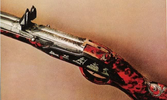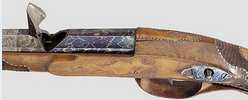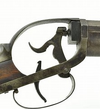You are using an out of date browser. It may not display this or other websites correctly.
You should upgrade or use an alternative browser.
You should upgrade or use an alternative browser.
Were the first inlines (19th Century question)
- Thread starter 4v50 Gary
- Start date
Jackrabbit1957
Member
- Joined
- Apr 6, 2018
- Messages
- 2,876
Joselyn carbine may fit the question? It was cartridge loaded though. I got to shoot one Saturday. What about the Sharps paper cutter? Galleger and Burnside maybe. Or are you looking specifically for something loaded from the front? I would think some of the small boot pistols would qualify as inlines.
hawg
Member
Shanghai McCoy
Member
The M1819 Hall rifle was originally a flintlock that was an "inline" and was later converted to percussion cap. I saw a single shot pistol at the Steamboat Arabia Museum that was also an inline configuration.
- Joined
- Dec 19, 2002
- Messages
- 22,510
Where's the touch hole on the Hall. We had a Hall and the nipple was on the top. With a cap and the hammer on top the breech was (theoritically sealed) but what about the flintlock fired Hall?
BTW, read that the soldiers could remove the breech and have a boot pistol. Dunno if anyone ever did. Same could be done with the P-08.
BTW, read that the soldiers could remove the breech and have a boot pistol. Dunno if anyone ever did. Same could be done with the P-08.
hawg
Member
Was the flap up the fired position? How much backblast?
The flap would have been up for priming. Since it's a closed system I don't think it would have been left up for firing.
hawg
Member
I can see it being down to be fired (clear lline of sight) but does it pop up when fired?
I don't really know but I would think it would.
Acorn Mush
Member
hawg
Member
What year was the Babcock rifle? It's really a simple underhammer. Trigger guard is the spring. I suspect the Colt predates it as Underhammers came about around 1840s.
Around the 1850's.
The Hall did not seal the breech at all. The would be an enormous amount of leakage when fired. Ambrose Burnsides experience with the Hall led him to build his carbine with a breech that was sealed by the cartridge.
There were several versions of “inline” flintlocks. Various methods of sealing, or not sealing the breech. The fact that the side lock is still used shows the success of the inline mechanism.
Kevin
There were several versions of “inline” flintlocks. Various methods of sealing, or not sealing the breech. The fact that the side lock is still used shows the success of the inline mechanism.
Kevin
Jackrabbit1957
Member
- Joined
- Apr 6, 2018
- Messages
- 2,876
Check out the Morse carbine, first US centerfire cartridge gun. Would that qualify as an inline?
theotherwaldo
Member
My first in-line was a CVA Blaser kit that was missing a bunch of parts, including the trigger and hammer.
I paid $20.00 for this mess and then started researching what I would need to complete the build.
19th and 18th century designs were usually overly complicated and ornate, often approaching the absurd and the inherently unsafe.
I wound up emulating those from a Stevens Favorite single-shot .22 action.
The finished gun was supposed to wind up looking like this - but didn't.
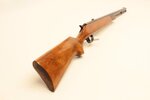
Let's just say that I played with it a bit... .
I paid $20.00 for this mess and then started researching what I would need to complete the build.
19th and 18th century designs were usually overly complicated and ornate, often approaching the absurd and the inherently unsafe.
I wound up emulating those from a Stevens Favorite single-shot .22 action.
The finished gun was supposed to wind up looking like this - but didn't.

Let's just say that I played with it a bit... .
Lefty38-55
Member
You are all wrong ... LOL!
The earliest 'inline' breech-loading fire locks date to the 1500s, like but this one example from the Royal Armory, however there are in reality 'custom' arms:
 collections.royalarmouries.org
collections.royalarmouries.org
Commercially, I would argue that the 1st truly available black powdah inline was the flintlock Hall rifle, a breech-loading rifle that was patented in 1810 and fielded to US troops, from the Harpers Ferry Armory, in 1819. While the French Chaumette inline breech loader dates from 1720 and the English Ferguson rifle (Rev War era) dates from 1770 pre-date the Hall, those too are/were essentially custom items.
Unlike Eli Whitney, who all too often gets the credit for interchangeable parts, the parts for his cotton gins were only interchangeable from those built within the SAME batch. John Hall (Portland, ME) was a mechanical genius and not only invented the Hall breech-loading rifle, but all the means to produce it in quantity and where all parts were truly interchangeable. He invented the tooling, gauging and inspection gauges & systems, horizontal milling, drive wheel counter-weights to eliminate tool chatter (from the water-driven machinery), and most importantly - the micrometer as we still know it today - as well as the standardized/unified thread forms that we (the US) still use today. On my original flintlock Hall, I can replace any of the 10-32 threads with a modern machine screw and it fits perfectly!
During the acceptance trial of the Hall rifle at the US Military Trials, they tested 100 rifles and all passed all of the specifications and performance tests. Although he won the contract, to prove his machining methods and gauging/inspection ideas/patents, he then had all 100 taken apart and put into piles, with the parts all mixed up from which rifle they originated from. Then those supporting the tests reassembled all 100 of the rifles, taking a part randomly from each of the piles ... and one again all 200 passed all of the testing! And as things like this typically end up ... he himself reaped no financial reward from his many inventions, patented or not, and died a pauper ... whereas the military industrial complex garnered the glory ... and $$$!
The earliest 'inline' breech-loading fire locks date to the 1500s, like but this one example from the Royal Armory, however there are in reality 'custom' arms:
Collections Online
Commercially, I would argue that the 1st truly available black powdah inline was the flintlock Hall rifle, a breech-loading rifle that was patented in 1810 and fielded to US troops, from the Harpers Ferry Armory, in 1819. While the French Chaumette inline breech loader dates from 1720 and the English Ferguson rifle (Rev War era) dates from 1770 pre-date the Hall, those too are/were essentially custom items.
Unlike Eli Whitney, who all too often gets the credit for interchangeable parts, the parts for his cotton gins were only interchangeable from those built within the SAME batch. John Hall (Portland, ME) was a mechanical genius and not only invented the Hall breech-loading rifle, but all the means to produce it in quantity and where all parts were truly interchangeable. He invented the tooling, gauging and inspection gauges & systems, horizontal milling, drive wheel counter-weights to eliminate tool chatter (from the water-driven machinery), and most importantly - the micrometer as we still know it today - as well as the standardized/unified thread forms that we (the US) still use today. On my original flintlock Hall, I can replace any of the 10-32 threads with a modern machine screw and it fits perfectly!
During the acceptance trial of the Hall rifle at the US Military Trials, they tested 100 rifles and all passed all of the specifications and performance tests. Although he won the contract, to prove his machining methods and gauging/inspection ideas/patents, he then had all 100 taken apart and put into piles, with the parts all mixed up from which rifle they originated from. Then those supporting the tests reassembled all 100 of the rifles, taking a part randomly from each of the piles ... and one again all 200 passed all of the testing! And as things like this typically end up ... he himself reaped no financial reward from his many inventions, patented or not, and died a pauper ... whereas the military industrial complex garnered the glory ... and $$$!
- Joined
- Dec 19, 2002
- Messages
- 22,510
Nah, I'm thinking muzzle loaders. Still waiting for a response from Alex (curator at Springfield).Check out the Morse carbine, first US centerfire cartridge gun. Would that qualify as an inline?
- Joined
- Dec 19, 2002
- Messages
- 22,510
Looking at the breechloading wheellock it appears that the touchhole is on the side. The same may be said of LaChamette that the Ferguson was based on. Touch hole is still on the side.You are all wrong ... LOL!
The earliest 'inline' breech-loading fire locks date to the 1500s, like but this one example from the Royal Armory, however there are in reality 'custom' arms:Collections Online
collections.royalarmouries.org
Commercially, I would argue that the 1st truly available black powdah inline was the flintlock Hall rifle, a breech-loading rifle that was patented in 1810 and fielded to US troops, from the Harpers Ferry Armory, in 1819. While the French Chaumette inline breech loader dates from 1720 and the English Ferguson rifle (Rev War era) dates from 1770 pre-date the Hall, those too are/were essentially custom items.
Unlike Eli Whitney, who all too often gets the credit for interchangeable parts, the parts for his cotton gins were only interchangeable from those built within the SAME batch. John Hall (Portland, ME) was a mechanical genius and not only invented the Hall breech-loading rifle, but all the means to produce it in quantity and where all parts were truly interchangeable. He invented the tooling, gauging and inspection gauges & systems, horizontal milling, drive wheel counter-weights to eliminate tool chatter (from the water-driven machinery), and most importantly - the micrometer as we still know it today - as well as the standardized/unified thread forms that we (the US) still use today. On my original flintlock Hall, I can replace any of the 10-32 threads with a modern machine screw and it fits perfectly!
During the acceptance trial of the Hall rifle at the US Military Trials, they tested 100 rifles and all passed all of the specifications and performance tests. Although he won the contract, to prove his machining methods and gauging/inspection ideas/patents, he then had all 100 taken apart and put into piles, with the parts all mixed up from which rifle they originated from. Then those supporting the tests reassembled all 100 of the rifles, taking a part randomly from each of the piles ... and one again all 200 passed all of the testing! And as things like this typically end up ... he himself reaped no financial reward from his many inventions, patented or not, and died a pauper ... whereas the military industrial complex garnered the glory ... and $$$!
if we're talking early breechloaders, there were those shield guns of Henry VIII. I'm interested in guns with the touchhole behind the powder charge and not adjacent to it. BTW, Koreans and Japanese knew about breechloading cannons and some of the ships in that battle (1592) that had the ironclad turtle ships were breechloaders. The Europeans did the same thing about the same time BUT as with almost all breechloaders, gas leakage was an issue which wasn't resolved until the advent of the metallic cartridge (and yes, steel cylindrical cartridges were around before copper and brass were).
Back on topic: early guns with touchhole in line with the powder charge.
Lefty38-55
Member
The touchhole on the Halls are inline, so much so that because either the flint cock or percussion hammer are 'in line', the sights are set off to the left side of the barrel!
- Joined
- Dec 19, 2002
- Messages
- 22,510
Regarding revolvers, I showed my class images of a flintlock revolver handgun. A couple of weeks later I showed them images of a wheelock revolver longgun and finally a matchlock revolver longgun. Erhard Wolf's book, Jager Feuerwaffen has excellent photos.
Lefty38-55
Member
Thanks Lefty. Must have been some backblast then.
Backblast: Ya' think? Although in this photo I opine that perhaps the roundball rolled forward off the charge and may have been sitting at the interface of the breech. They do leak gas, which is why there are those ~4" long 'side slots' on either side of the action 1/2-way up the wood, but mine don't leak like this one!
On my flint version, the interface between the barrel and the breech (akin to a revolver forcing cone area) only has a < 0.003" gap, as the action will not close if a piece of tissue paper is inserted in the breech. Amazing for something built in the 1830s!
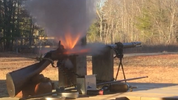
Breech:
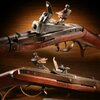
Barrel/Rifling: The rifling on my flintlock model looks LIKE NEW! Amazing for 185-years young ...

Some more interesting features of the Hall rifles are:
* All interchangeable parts
* 1st issued breech loaded to a standing army
* A truly ambidextrous rifle, both LH & RH'd people can operate/shoot it. (Hammer is amidst the action, so the sights are actually off-set to the left by a good amount!).
* Has a screw adjustable sear to adjust the let-off from a hair trigger to a battle trigger
* Had a rate of fire twice that of muzzleloaders at that time (early 1800s)
* Accuracy was also greater than muskets of that period
A great into article attached! I have a good 1/2-dozen more if people are interested in them ...
Similar threads
- Locked
- Replies
- 44
- Views
- 4K
- Replies
- 53
- Views
- 2K


